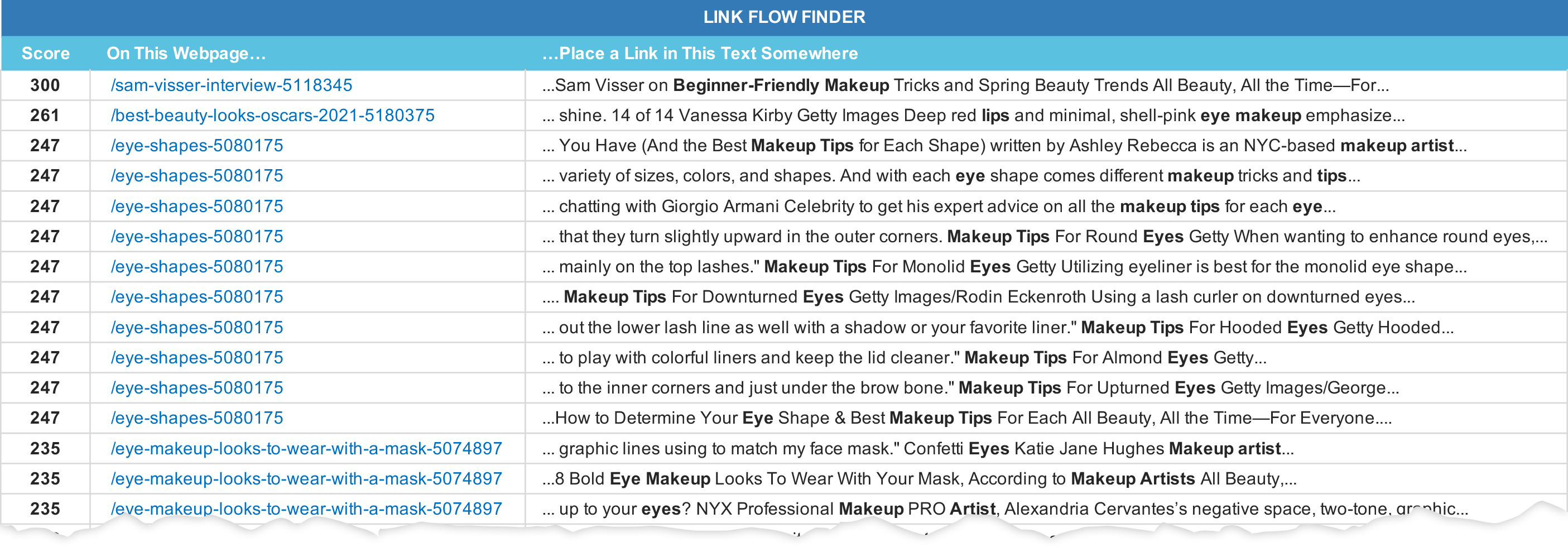Call it link flow. Link equity. PageRank.
No matter what you call it, how your pages are linked to and from one another is one of the key drivers of your rankings in search.
But managing internal linking is “painful,” “time-burning,” and ”mind-numbing,” according to SEO professionals we’ve heard from, which is why many SEO teams put internal link building on the back burner.
Doing so is a big mistake.
In our experience from running analyses on tens of thousands of websites, getting the link flow to each of your key pages and keeping it there can make the difference between rising to the top of the search engine results pages (SERPs) and languishing with the rest of the pack.
Fortunately, AI can save you time and effort in tackling this critical area of SEO.
Solutions like Market Brew from Brewco are now using the power of artificial intelligence to show you how, when, and where to optimize your internal linking to achieve your highest SERP potential.
Do I Need to Optimize My Internal Links?
Most sites do. But not all.
One of the key applications of AI in SEO – built off this foundational patent — is understanding what actually drives rankings for any given keyword.
There’s no single solution here. Every SERP weighs factors differently, from keyword to keyword and country to country.
You’ll hear lots of points of view on what matters most for SEO. Some say it’s semantic factors. Others say domain factors. There’s also page performance, internal linking, and the list goes on.
All of these points of view are sometimes right and sometimes wrong.
Only by building search engine models can you know which of these factors matter for your keywords and how much they matter.
Market Brew uses particle swarm optimization, a branch of AI, to build these models.
Where search engines look at site and page features and apply their algorithms to develop the SERP rankings, Market Brew reverses that process. Our technology looks at site and page features as well as SERP rankings to understand the weights of 14 “buckets” of algorithms.
The system tests and adjusts the weights of these algorithmic pillars from a continually updated baseline Google model until the keyword-specific SERP (for a selected set of benchmark sites) matches the real-world SERP.
When this convergence happens, we now have a useful model:

Each site in the model is scored for these various factors and all of their sub-factors.
When these scores are hashed against the custom model, the platform calculates where the biggest statistical gaps exist. It then exposes what SEO changes will make the biggest (and fastest) difference in your SERP position.
With this model in hand, you can now determine whether your link flow is holding back your ranking page for that keyword.
For most sites, it is.
Artificial intelligence can show you how, when and where to optimize internal linking to achieve your highest ranking potential.
How to Determine Which Pages Need More (or Less) Internal Linking Support
When your model indicates that link flow is one of the key gaps holding you back for the ranking page, it is probably a problem for multiple pages. That’s why we recommend taking a site-holistic approach when working on link flow.
Market Brew runs an analysis on all of the pages it crawls, scoring all external and internal links to understand how link flow is being distributed across those pages.

This report shows where the site’s link flow is pooling after considering all the inputs and outputs of each page. We often see (as we do here) that search-irrelevant pages like About Us pages and legal notices get too much link flow.
In most cases, your homepage should get the most link flow, followed by key search landing pages – important product category, products, and service pages, for example.
The ideal shape of a link flow graph is a terraced one. But many sites have flat link flow distribution which doesn’t signal to the search engine crawlers which pages are most important to the user.
A frequent distribution flattener is the mega menu. These are usually horrible for SEO, so unless they are critical for the user journey and conversion, you should consider other ways to guide users through your site that don’t impact your pages’ SEO power.
When our clients optimize their link flow, they review the distribution report, determine which pages should have the most link flow, and then set about balancing link flow using the algorithmic support provided.
How Can We Improve Link Flow to Pages?
A number of factors impact your pages’ link flow scores:
- The number and value of external site links to those pages.
- The number and value of internal links to those pages.
- How much link flow each page is losing through off-page links.
- Algorithmic downgrades, which dampen the value of the pages’ link flow.
In the table below, the page we analyzed is losing about 4.5% of its current link flow, and page downgrades are erasing more than 50% of what’s left.

You can add more net link flow to a page by:
- Getting more external links to that page.
- Restructuring internal linking to push more link flow to important pages and reduce it for less important (for search) pages.
- Reducing link loss from that page.
- Correcting various factors that are negatively impacting your link flow.
Get More External Links to Your Pages
Job one is increasing the link flow potential of your pages. Getting external links to them is one way to do this.
Is domain rank an area you need to work on, according to the AI model?
If so, paying for backlinks is worthwhile. Understanding where you want to add link flow will help you optimize your backlinking program for both domain rank and link flow.
But paying for backlinks to boost link flow doesn’t deliver optimal ROI unless the model has identified domain rank as a ranking factor you need to address. There are better and cheaper ways to improve the link flow to your important pages using internal linking.
Build the Right Internal Links from the Right Pages
Using backlinks to increase the overall link flow to your key pages is useful but also expensive and slow. Using proper internal linking to balance your link flow has the advantage of being free and quick.
When you build your internal link strategies, you must reinforce the key meanings of your pages by using link text related to the focus keywords for each page. Focus on links from the pages which can deliver the most link flow, as well.
You can do this by hand, but using AI algorithms to show which parts of which pages to link from can save a huge amount of time and grief. The table below shows an example of these recommendations. You’ll want to review these AI-guided suggestions for suitability.

When you redistribute link flow to your important pages, you also decrease the link flow to your less important pages. This further signals to the crawlers which pages are important and which aren’t.
You can also reduce link flow to pages that don’t need it by removing links to those pages or changing the power of those links. Again, there are algorithms to show you the way.
Reduce Link Flow Loss
Many pages are unnecessarily giving up link flow to other sites. The most common causes of link loss are social media links and links to help sites, career sites, and user login sites.
Few of these pages, if any, need your link flow. Review the list of outgoing links (provided by our platform or other tools) and use the nofollow tag to stop the loss.
Eliminate the Page Issues That Hurt Your Link Flow
Over the years, search engines have deployed various algorithms to thwart the tactics of bad actors attempting to game search rankings.
Unfortunately, many websites unknowingly trigger these algorithms. Their pages are impacted negatively as a result, which dampens their link flow.
In our experience, this removes anywhere from 10% to 75% of a page’s net link flow. Reducing these issues can have the same impact as doubling or tripling the number of incoming links.
These are a few examples of issues that can hurt your link flow:
- Keyword stuffing.
- Too many outgoing links that look like paid or “advertorial” links.
- Duplicate content.
- Duplicate page titles or descriptions, to name a few.

We can help you understand which of these issues are impacting your pages, where the offending items are, and how to fix them.
How to Know You’ve Improved Your Link Flow
With each iteration of the steps above, you can improve the ranking power of the pages.
The quickest way to check your work and determine your next steps is to recrawl your site. This allows you to:
- Review the optimized link flow distribution to see what percentage of the link flow each page is getting.
- See how much you’ve been able to reduce issues that can downgrade your page on SERPs.
- Project the impact of the changes made on your statistical ranking power, which can translate to ranking position changes.
- Reanalyze the gaps between you and your higher-up competitors to determine where to focus next.
For more information on link flow building and its impact on search performance, read our ebook Using AI to Optimize Internal Linking for SEO.
What Else Do AI-Built Search Engine Models Deliver?
Search engine modeling using AI opens up an entirely new and better way to optimize your pages.
By understanding the relative importance of on- and off-page factors in rankings for your keywords and measuring how well your site and others score in those factors, you’ll know exactly where to spend your time to most efficiently and quickly improve your SERP positioning.
Ranking better faster is a great benefit, but not the only one Market Brew’s search engine modeling provides.
When you have a custom keyword model, you will also:
- Understand the true statistical difference between you and your competitors so you know where you can most easily gain traffic — and where you may be at risk.
- Get an accurate projection of the impact of your SEO changes on your ranking scores and search positions 60 days before they appear in the SERPs.
- Track the impact of your competitors’ moves and counteract them immediately, versus when their impact shows up 60 days from now.
- Avoid risks to your SERPs standing by testing redesigns, navigation bar changes, and other non-SEO changes before you even launch them.
Our Guide to Search Engine Modeling goes into more depth about how and why this approach will help you win in SEO. For more information, click on the links in this article or visit www.brewco.ai.
Search engines are just sets of algorithms embodied through neural networks, rules, and other systems. They’ve reached a level of complexity that humans can’t outthink.
Only through artificial intelligence of our own can we begin to fathom what’s really going on and harness this knowledge to improve our share of search traffic.
Our work in the area has been developing for years, and we’re not stopping.
We’re currently expanding our semantic analysis models to start to understand what drives Google’s E-A-T (Expertise, Authoritativeness, and Trustworthiness), working to measure the true impact of Core Web Vitals, and reviewing other emerging search considerations to determine their impact.
We’d love to get your feedback on what you want to see modeled next. You can post questions on Brewco’s social media feeds, on the Ask the Search Engineer blog, or by leaving us a message on the Brewco website.
Achieve your site's true traffic potential
Download our guide to Mastering Link Flow
The opinions expressed in this article are the sponsor's own.



